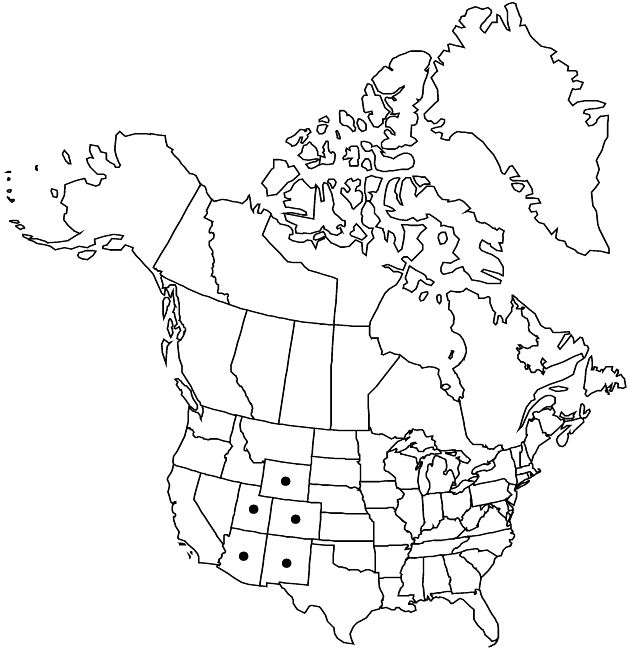Difference between revisions of "Heterotheca fulcrata var. amplifolia"
Rev. Heterotheca Pyllotheca, 74. 1996.
FNA>Volume Importer |
imported>Volume Importer |
||
| (3 intermediate revisions by 2 users not shown) | |||
| Line 6: | Line 6: | ||
|place=74. 1996 | |place=74. 1996 | ||
|year=1996 | |year=1996 | ||
| + | }} | ||
| + | |special_status={{Treatment/ID/Special_status | ||
| + | |code=E | ||
| + | |label=Endemic | ||
}} | }} | ||
|basionyms={{Treatment/ID/Basionym | |basionyms={{Treatment/ID/Basionym | ||
|name=Chrysopsis amplifolia | |name=Chrysopsis amplifolia | ||
|authority=Rydberg | |authority=Rydberg | ||
| + | |rank=species | ||
|publication_title=Bull. Torrey Bot. Club | |publication_title=Bull. Torrey Bot. Club | ||
|publication_place=31: 648. 1905 | |publication_place=31: 648. 1905 | ||
| Line 16: | Line 21: | ||
|name=Chrysopsis foliosa var. amplifolia | |name=Chrysopsis foliosa var. amplifolia | ||
|authority=(Rydberg) A. Nelson | |authority=(Rydberg) A. Nelson | ||
| + | |rank=variety | ||
}} {{Treatment/ID/Synonym | }} {{Treatment/ID/Synonym | ||
|name=Chrysopsis nitidula | |name=Chrysopsis nitidula | ||
|authority=Wooton & Standley | |authority=Wooton & Standley | ||
| + | |rank=species | ||
}} | }} | ||
|hierarchy=Asteraceae;Asteraceae tribe Astereae;Heterotheca;Heterotheca fulcrata;Heterotheca fulcrata var. amplifolia | |hierarchy=Asteraceae;Asteraceae tribe Astereae;Heterotheca;Heterotheca fulcrata;Heterotheca fulcrata var. amplifolia | ||
| Line 34: | Line 41: | ||
|elevation=1300–3500 m | |elevation=1300–3500 m | ||
|distribution=Ariz.;Colo.;N.Mex.;Utah;Wyo. | |distribution=Ariz.;Colo.;N.Mex.;Utah;Wyo. | ||
| − | |discussion=<p>Variety amplifolia is similar in most respects to < | + | |discussion=<p>Variety amplifolia is similar in most respects to <i></i>var.<i> fulcrata</i>, but the leaf indument is usually densely short-strigose (50–200 hairs/mm2) with few or no glands. Some plants maintain the proximal leaf shape well up the stem, only the few distalmost leaves becoming narrowly ovate-lanceolate; those are similar to <i>Heterotheca villosa </i>var.<i> pedunculata</i>. In southern Utah and eastern Arizona, small-leaved plants may be similar to <i>H. zionensis</i> due to the density of leaf hairs, but in that area the latter typically have densely stipitate-glandular phyllaries, moderately stipitate-glandular distal leaves, and no large bracts subtending the heads.</p> |
|tables= | |tables= | ||
|references= | |references= | ||
| Line 43: | Line 50: | ||
-->{{#Taxon: | -->{{#Taxon: | ||
name=Heterotheca fulcrata var. amplifolia | name=Heterotheca fulcrata var. amplifolia | ||
| − | |||
|authority=(Rydberg) Semple | |authority=(Rydberg) Semple | ||
|rank=variety | |rank=variety | ||
| Line 57: | Line 63: | ||
|publication title=Rev. Heterotheca Pyllotheca, | |publication title=Rev. Heterotheca Pyllotheca, | ||
|publication year=1996 | |publication year=1996 | ||
| − | |special status= | + | |special status=Endemic |
| − | |source xml=https:// | + | |source xml=https://bitbucket.org/aafc-mbb/fna-data-curation/src/2e0870ddd59836b60bcf96646a41e87ea5a5943a/coarse_grained_fna_xml/V19-20-21/V20_533.xml |
|tribe=Asteraceae tribe Astereae | |tribe=Asteraceae tribe Astereae | ||
|genus=Heterotheca | |genus=Heterotheca | ||
Latest revision as of 20:03, 5 November 2020
Stems moderately to densely short-strigose, eglandular or nearly so. Distal cauline leaf blades ovate to lanceolate, 17–40 × 5–15 mm, margins with few long-hispido-strigose cilia, faces moderately to densely short-strigose (small leaves sometimes nearly white), eglandular or sparsely stipitate-glandular. Subtending bracts ovate, usually large (6–17 × 1.5–5.5 mm), leaflike, well differentiated (sometimes densely strigose when small). Involucres 6.4–10 mm. Phyllaries lanceolate to triangular-lanceolate, faces moderately strigose, usually eglandular. Ray laminae 8.5–14(–16) mm. Cypsela faces moderately strigose. 2n = 18, 36.
Phenology: Flowering (Jun–)July–Sep(–Oct).
Habitat: Dry gravelly soils, coarse granitic soils, disintegrated granite slopes, high rocky summits, dry grasslands with sagebrush, roadsides, transition zone, Ponderosa pine–oak associations, pinyon-juniper zone at edge of Upper Sonoran Desert, mid to higher montane zone
Elevation: 1300–3500 m
Distribution

Ariz., Colo., N.Mex., Utah, Wyo.
Discussion
Variety amplifolia is similar in most respects to var. fulcrata, but the leaf indument is usually densely short-strigose (50–200 hairs/mm2) with few or no glands. Some plants maintain the proximal leaf shape well up the stem, only the few distalmost leaves becoming narrowly ovate-lanceolate; those are similar to Heterotheca villosa var. pedunculata. In southern Utah and eastern Arizona, small-leaved plants may be similar to H. zionensis due to the density of leaf hairs, but in that area the latter typically have densely stipitate-glandular phyllaries, moderately stipitate-glandular distal leaves, and no large bracts subtending the heads.
Selected References
None.